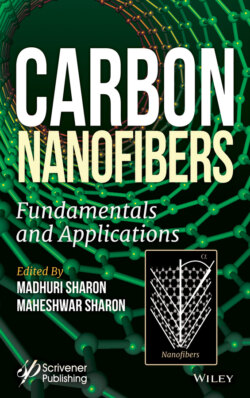Читать книгу Carbon Nanofibers - Группа авторов - Страница 84
3.6.2 Chemical Vapor Deposition (CVD)
ОглавлениеThe CVD method is the most common method for bulk production of carbon nanomaterials. Different hydrocarbons are used as precursor for CNM. At high temperature (between 500 and 1200 °C) under pyrolytic condition, carbon is deposited on various metal catalysts (Fe, Co, and Ni). This method is described in detail in Chapter 1 of this book. The process parameters that are important for the synthesis of CNF are the ratio of hydrogen to carbon source flow, reaction time, and temperature [42].
In the CVD process, CNFs are usually produced by catalytic pyrolysis of hydrocarbons in the presence of a transition metal catalyst and a trace amount of sulfur to promote the formation of CNF. Precursors that have been successfully used to synthesize CNF by CVD method are methane, carbon monoxide, synthesis gas (H2/CO), ethyne or ethane, acetylene, etc. The hydrocarbon or the precursor, along with the catalyst, hydrogen gas, and a sulfur source, are introduced into the reactor. Ferrocene (C10H10Fe), dissolved in a suitable solvent, and iron pentacarbonyl (Fe(CO)5) are commonly used catalyst sources. The organometallic catalyst decomposes, forming clusters of iron (Fe) particles that act as nuclei for the formation and further growth of CNFs. The fibers grow as they move along the reactor, and the diameter of fibers increases by the classic chemical vapor deposition (CVD) mechanism. Both horizontal and vertical reactor configurations have been employed. The fibers coming out of the reactor, along with the off-gases, are trapped and separated via a series of cyclone separators or trap mechanisms located downstream of the reactor. The entire reactor assembly is enclosed within an electric furnace to supply sufficient heat to maintain the pyrolysis temperature of 500 to 1,200 °C. The characteristics of the fibers, such as their thickness and length, are controlled through careful manipulation of the parameters, such as the catalyst concentration, reaction time, and size of the catalyst particles produced. The CNFs prepared by catalytic thermal chemical vapor deposition show different morphologies such as cup-stacked CNF [43] and platelet CNF. For the preparation of CNF by the catalytic vapor deposition growth approach, several types of metal or alloys, which are able to dissolve carbon to form metal carbide, have been used as the catalyst, including iron, cobalt and nickel; chromium, vanadium and molybdenum. Generally, the structures of the CNF are governed by the shapes of the catalytic nano-sized metal particles. The growth mechanism has been proven as the deposition of the hydrocarbons dissolved in the metal particle and precipitated on the metal surface as graphitic carbon.
Hydrogen: The role of hydrogen is to accelerate or suppress the formation of carbon by either decomposing the inactive metal carbides to form active metal [44], or by removing the surface carbon and precursors of carbon which leads to active site blocking.
Temperature: The diffusion and precipitation rates of carbon atoms and availability of carbon atoms are affected by temperature [45]. The precipitation of carbon on the metal catalysts can be either on the surface of CNF or internal. At low temperatures, carbon atoms can only precipitate on the surface areas of the catalyst particles, while the diffusing and dissolution rates of carbon atoms increase with the temperature, and carbon atoms then get into the internal areas of the catalysts to form CNF [46]. The temperature requirement depends on the precursor used; e.g., methane requires higher temperature than propane due to its higher decomposition energy to carbon and hydrogen (37.8 and 26.0 kJ mol–1 H2 for methane and propane, respectively) [47]. Increased reaction temperatures favor the migration of catalyst particles on the support surface, which results in their aggregation, leading to the growth of thicker CNFs [38]. The diameter and the structure of grown CNFs are strongly dependent on the temperature of the CCVD process. The synthesis temperature has an indirect influence on the CNF structure through various diffusion rates of carbon into the catalyst particles and different orientations of the graphene layers precipitated on the metal nanoparticle [38].
Growth or Reaction Time: The growth time plays a major role in tailoring the morphology of nanomaterials in terms of diameter and density of growth [48]. In the initial stage of growth, a part of the metal catalyst (nickel) surface is covered by carbon, leading to formation of relatively catalyst-rich carbon area. In the next stage, dissolved carbon is released to form CNF with the lift-off of the former catalyst-rich carbon particles out of the substrate surface. Generally, the reaction duration is 60 min, while a total time of 3 h is needed for the synthesis of CNF in the decomposition of ethylene over an unsupported Ni-Cu alloy [49].
Decomposition of Hydrocarbon: This is the final stage, where decomposition of hydrocarbon on the new catalyst initiates new deposition of carbons from the same particle, covering the host surface completely by a dense layer of CNF.
Size of Catalyst: It is well known that the diameter of nano fibers is controlled by the size of the catalyst particle responsible for their growth [50]. The parallel orientation of the graphene layers and the lower diameter arose from the changes to the catalyst and the carbon precursor. The use of an iron catalyst promotes the growth of CNTs, whereas nickel favors the formation of herringbone CNFs [51].
